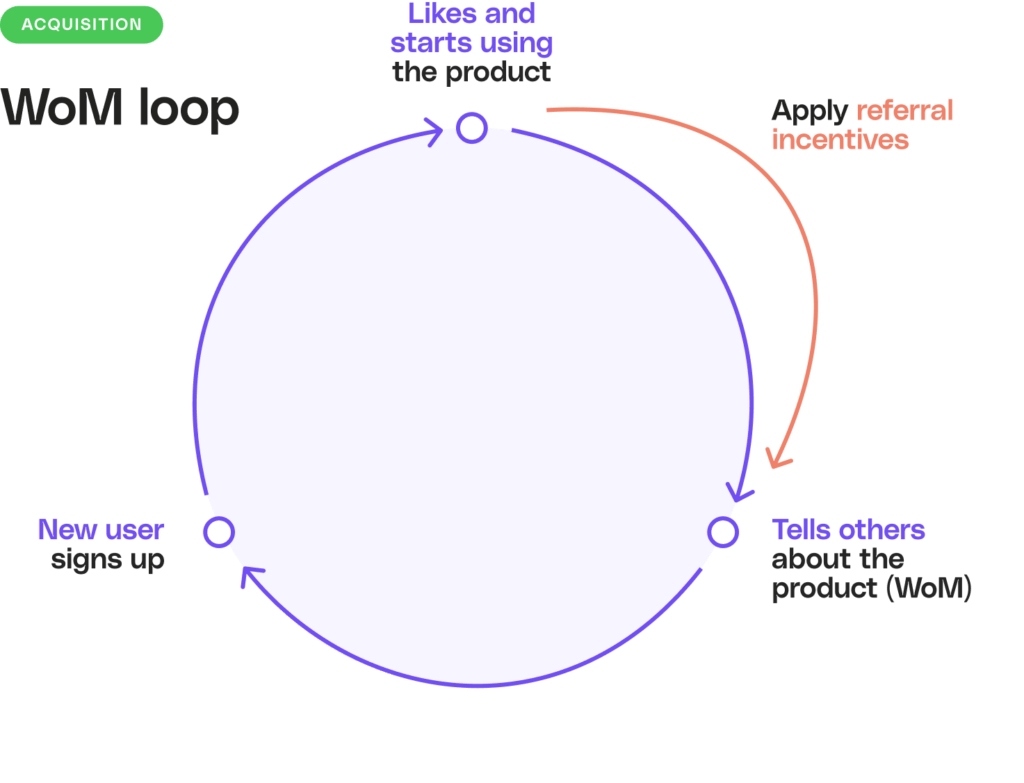In today's digital age, the success of a business often hinges on its ability to attract and retain customers. Traditional marketing strategies (e.g. SEO, paid ads, events etc.), while effective, can be expensive and time-consuming.
Enter the concept of a viral loop. Understanding what a viral loop is and how it works can give businesses a powerful tool to grow their customer base and increase brand awareness.
Key Takeaways:
- Nature of Viral Loops: A marketing strategy that uses social sharing and word-of-mouth to significantly increase brand exposure and customer acquisition in a self-sustaining manner.
- Key Elements: Involves a trigger for user participation, an incentive to share, and a method for inviting others (like referral links).
- Benefits: Offers exponential growth at lower costs than traditional marketing, and builds brand loyalty through peer recommendations.
- Implementation Challenges: Requires seamless sharing, attractive incentives, and must avoid overstating product benefits or ignoring negative feedback.
- Measuring Success: Focus on key metrics like referral numbers and conversion rates, and continually adapt based on user feedback and data analysis.
Understanding the concept of a viral loop?
A viral loop, in its simplest form, is a marketing strategy that capitalizes on the rapid spread of information through networks or communities. It leverages the power of word-of-mouth marketing and social sharing to exponentially increase brand exposure.
By designing a system that encourages users to share a product or service with others, businesses can achieve viral growth and create a self-sustaining loop of customer acquisition.
Definition of a viral loop
At its core, a viral loop is a feedback loop that drives customer acquisition. It begins with a customer who discovers and uses a product or service and then shares their positive experience with others.
This sharing prompts new customers to try the product or service, who then go on to share their experience as well. This cycle continues, generating ongoing growth for the business.

The importance in marketing
Viral loops offer numerous benefits to businesses. First and foremost, they have the potential to generate exponential growth without a significant increase in marketing costs.
By utilizing the power of social networks and amplifying word-of-mouth recommendations, businesses can reach a wider audience organically.
Additionally, this network effect helps to build brand loyalty and trust, as customers tend to trust recommendations from their peers more than traditional advertising.
The mechanics
While the concept of a viral loop may seem straightforward, implementing an effective one requires careful planning and execution. Let's explore the key components that make up a successful viral loop and how they work together to drive customer acquisition.
Key components
A viral loop typically consists of three core elements: a trigger, an incentive, and an invitation.
- The trigger is the initial action that prompts a user to start the viral sharing cycle. This can be anything from an engaging social media post to a compelling email.
- The incentive provides motivation for users to share the product or service. This can be in the form of discounts, rewards, or exclusive access.
- The invitation is the means by which users invite others to join the loop, such as a referral link or social sharing buttons.

How viral loops work
Once the key components are in place, viral loops rely on the power of social sharing and word-of-mouth marketing. A customer who receives a trigger and finds value in the product or service is more likely to share it with others.
As new users enter the loop through the invitation, they receive the same trigger and are incentivized to share, perpetuating the cycle. This continuous loop of acquisition and sharing can drive exponential growth, creating a powerful marketing engine for businesses.
Creating a successful viral loop
Building a successful viral sharing cycle requires careful strategy and execution. Let's explore some key strategies for creating an effective viral loop and common mistakes to avoid.
Strategies for building a viral loop
One effective strategy for building a viral loop is to make the sharing process seamless and rewarding. By removing barriers, such as complex sharing mechanisms or lengthy sign-up processes, businesses can encourage more users to participate.
Additionally, offering compelling incentives that align with the target audience's needs and desires can motivate users to share the product or service with others.
| Strategy | Description | Key Consideration |
|---|---|---|
| Seamless Sharing | Ensure the process for sharing is as simple and intuitive as possible, minimizing steps for users to share with their network. | Focus on integrating direct sharing buttons for major social networks and providing clear, compelling calls-to-action. |
| Aligning Incentives | Offer rewards or incentives that are valuable to your audience, encouraging them to share your product or service. | Incentives should be relevant and desirable to the target audience, driving genuine interest and participation. |
| Feedback Loop Integration | Incorporate mechanisms for gathering and analyzing user feedback to continually refine and improve the viral loop. | Utilize analytics tools to monitor engagement and conversion, adjusting strategies based on real user data and feedback. |
| Leveraging Social Proof | Use testimonials, user-generated content, and social shares as proof of your product’s value and popularity. | Social proof can significantly enhance trust and credibility, making new users more likely to engage with and share your offering. |
Common mistakes to avoid
While viral loops have the potential for great success, there are common pitfalls that businesses should avoid. Overselling or exaggerating the benefits of a product or service can lead to disappointment and damage the credibility of the viral loop.
It is also crucial to monitor and address any negative feedback or issues promptly, as they can hinder the loop's progress. Finally, failing to optimize and iterate on the viral loop based on user feedback and data can limit its effectiveness.
The impact on business growth
Implementing a successful viral loop can have a significant impact on business growth. Let's explore the benefits of using viral loops and potential risks and challenges that businesses may face.
Benefits
One of the primary benefits of using social media growth strategies is the potential for rapid and exponential growth. By harnessing the power of social sharing and word-of-mouth marketing, businesses can reach a wider audience and acquire customers at a fraction of the cost of traditional marketing methods.
Viral loops also have the potential to increase customer engagement and retention, as users who participate in the loop often feel a sense of ownership and loyalty toward the brand.
Potential risks and challenges
While the rewards of a successful viral loop are enticing, businesses should be aware of potential risks and challenges. If not executed correctly, viral loops can lead to negative customer experiences or backlash if the product or service does not meet expectations.
Additionally, managing the exponential growth that a social media buzz can generate can be overwhelming if proper systems and support are not in place. It is essential to monitor and adapt to user feedback and data to ensure the continued success of the social network effect.
Measuring the effectiveness
Understanding the performance and impact of a viral loop is crucial for ongoing improvement and optimization. Let's explore the key performance indicators (KPIs) businesses can use to measure the effectiveness of their social media viral loops.
Key performance indicators
When measuring the effectiveness of a viral loop, businesses can look at KPIs such as the number of referrals generated, the conversion rate of referred customers, and the overall growth rate.
Monitoring customer engagement and retention rates can also provide insights into the effectiveness of the loop.
By regularly analyzing these metrics, businesses can identify areas for improvement and make data-driven decisions to optimize their viral loops.
Improving your viral loop performance
To improve the performance of a viral loop, businesses should continuously
- iterate and test different strategies
- gathering feedback from users and analyzing data can help identify bottlenecks or areas of improvement.
- experiment with different incentives, triggers, and sharing mechanisms
By maintaining a proactive approach to optimization, businesses can maximize the impact and drive sustainable growth.
In conclusion, viral loops represent an innovative and impactful marketing strategy that can supercharge customer acquisition and brand awareness.
By understanding the concept, businesses can harness the power of social sharing and word-of-mouth marketing to achieve exponential growth.
Through careful planning and execution, businesses can create successful viral loops that drive customer acquisition and propel business growth.
Unlock exponential growth with Cello
Ready to transform your users into a dynamic force for your SaaS product's growth? Cello offers the perfect solution to add a peer-to-peer referral program effortlessly. With minimal development time and a success-based pricing model, you can start seeing results from day one. Experience the seamless integration, automated rewards, and comprehensive management tools that make sharing a breeze. Don't miss out on the opportunity to drive sustainable, user-led growth. Book a demo today to see Cello in action and kickstart your viral loop journey.
Resources
Related articles

7 Best B2B Referral Software (2025 Guide)
Which referral software should I choose? In the world of referral marketing, choosing the right ...

Scaling and Maintaining a B2B User Referral Program
Learn how to set the right incentives for B2B SaaS user referral programs

What are User Generated Content Growth Loops?
User Generated Growth (UGC) loop is a growth engine where users create content that attracts ...

